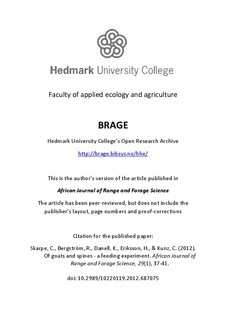Of goats and spines : a feeding experiment
Journal article, Peer reviewed

Åpne
Permanent lenke
http://hdl.handle.net/11250/134514Utgivelsesdato
2012Metadata
Vis full innførselSamlinger
Originalversjon
Skarpe, C., Bergström, R., Danell, K., Eriksson, H., & Kunz, C. (2012). Of goats and spines : a feeding experiment. African Journal of Range and Forage Science, 29(1), 37-41. doi: 10.2989/10220119.2012.687075 http://dx.doi.org/10.2989/10220119.2012.687075Sammendrag
Spines in plants have evolved to reduce mammalian herbivory, and their main function may be to protect twigs more than photosynthetic tissue. Type and frequency of spines vary in different scales. We hypothesised that different types of spines affect animal foraging through different mechanisms. We studied feeding behaviour by twig browsing goats in relation to two types of spines of Acacia tortilis using experimental manipulation of the occurrence of spines. Feeding time, number of biting actions, number and diameter of bites on trees (post-trial) and total intake were recorded. The removal of either long straight spines or short hooked spines resulted in no feeding responses by goats. The removal of both types of spines tended to increase feeding time resulting in more and larger bites with larger bite diameters and in increased total intake and utilisation compared to control branches. The removal of spines gave no effects on feeding rate, expressed as biting actions/minute, number of twigs bitten/minute or intake rate (g/minute). Both types of spines reduced total intake and utilisation of browse, but the functional mechanisms were different with the long straight spines mainly influencing bite size and short hooked spines mainly affecting number of bites.
Beskrivelse
This is the postprint version of the article.